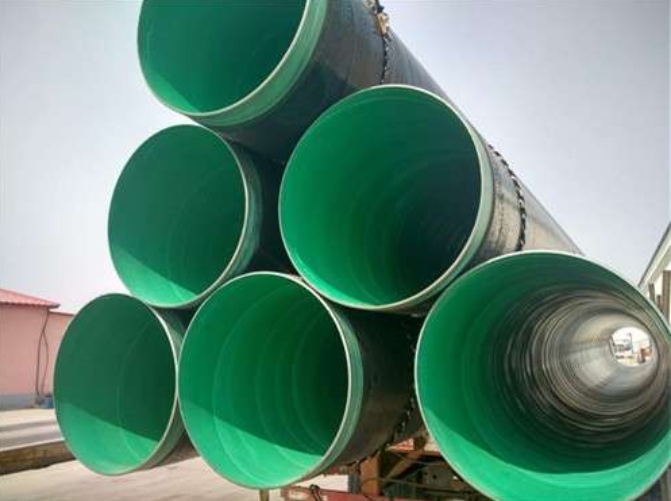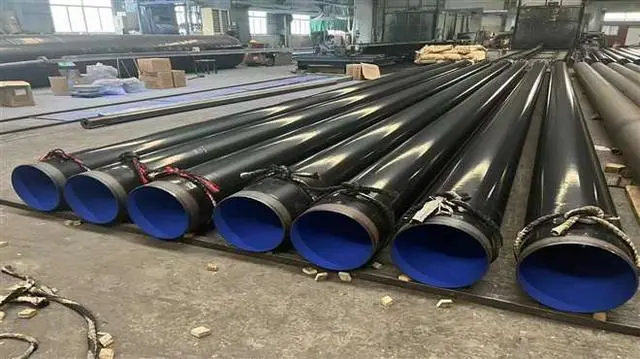Lined steel pipe is a specialized type of piping system that consists of an outer layer made of steel, typically carbon steel or stainless steel, and an inner lining made of a different material such as PTFE (polytetrafluoroethylene), PFA (perfluoroalkoxy), or FEP (fluorinated ethylene propylene). The purpose of lining the steel pipe is to provide enhanced corrosion resistance and chemical compatibility, making it suitable for conveying various corrosive fluids and substances. By combining the strength and durability of steel with the chemical inertness and non-stick properties of the lining material, lined steel pipes offer superior performance in demanding industrial applications.

Lined steel pipes play a critical role in several key industries, including oil and gas, chemical processing, and water treatment. In the oil and gas sector, where pipelines are exposed to aggressive substances like crude oil, natural gas, and drilling fluids, lined steel pipes offer excellent protection against corrosion and ensure the safe transportation of hydrocarbons over long distances. Similarly, in chemical processing plants handling highly corrosive chemicals such as acids, alkalis, and solvents, lined steel pipes prevent leaks and contamination while maintaining product purity.
Moreover, water treatment facilities rely on lined steel pipes to withstand harsh environments during purification processes involving chlorine compounds or other aggressive agents. Overall, the versatility and reliability of lined steel pipes make them indispensable components in ensuring efficient operations across various industrial sectors.
The outer layer of lined steel pipe plays a crucial role in providing structural integrity and protection against external elements. Common materials used for the outer layer include carbon steel and stainless steel.
Carbon steel is renowned for its strength and durability, making it an ideal choice for applications requiring high pressure and temperature resistance. On the other hand, stainless steel offers superior corrosion resistance properties, making it suitable for environments with corrosive substances.
Both carbon steel and stainless steel used in lined steel pipes exhibit excellent corrosion resistance properties. Carbon steel pipes are often coated with protective layers to enhance their resistance to rust and corrosion caused by exposure to moisture and chemicals.
Stainless steel, on the other hand, naturally forms a passive oxide layer that acts as a protective barrier against corrosion, ensuring longevity even in harsh environments. The combination of these corrosion-resistant materials in lined steel pipes provides an added layer of protection, making them ideal for applications where traditional materials may fail.
The inner lining material of lined steel pipes is where innovation meets functionality. Various types of lining materials are utilized to cater to specific industrial requirements. Popular choices include PTFE (Polytetrafluoroethylene), PFA (Perfluoroalkoxy), and FEP (Fluorinated Ethylene Propylene).
Each material offers unique advantages such as chemical resistance, temperature tolerance, and smooth surface finish. These linings not only protect the inner walls of the pipe from corrosive substances but also provide a barrier that ensures the purity of transported fluids.
The use of lined steel pipe over traditional materials such as unlined carbon or stainless steel brings numerous benefits across various industries. Lined pipes offer superior corrosion resistance compared to bare metal pipes, reducing maintenance costs and extending operational lifespan.
Additionally, the smooth inner surface provided by lining materials reduces friction losses during fluid flow, leading to improved efficiency in transportation systems. The enhanced chemical resistance properties of lined pipes make them indispensable in handling aggressive substances safely, preventing leaks or contamination that could pose risks to both personnel and equipment.
Lined steel pipes offer exceptional corrosion resistance, making them ideal for transporting harsh chemicals and corrosive substances in various industries. The inner lining material acts as a protective barrier between the corrosive fluid and the outer steel pipe, preventing any degradation or damage to the pipe itself. This corrosion resistance feature not only ensures the safety of the transported materials but also prolongs the lifespan of the lined steel pipe, reducing the need for frequent replacements or repairs.
One of the standout advantages of using lined steel pipes is their significantly longer lifespan when compared to unlined pipes. The combination of a durable outer steel layer and a chemically resistant inner lining material results in a robust pipeline system that can withstand harsh operating conditions for an extended period.
By effectively shielding the steel from corrosive elements, lined steel pipes experience minimal degradation over time, reducing maintenance costs and downtime associated with frequent replacements. This enhanced longevity not only benefits industries economically but also contributes to environmental sustainability by reducing material waste from worn-out pipelines.
The smooth inner surface of lined steel pipes plays a crucial role in minimizing friction losses during fluid transportation. Unlike traditional rough-surfaced pipes that can cause turbulence and energy loss due to friction, lined steel pipes provide a sleek pathway for fluids to flow smoothly without unnecessary resistance. This reduction in friction losses not only optimizes energy efficiency but also helps maintain consistent flow rates within pipelines, ensuring reliable operation across various industrial applications.
By offering an improved flow efficiency, lined steel pipes enable enhanced fluid transport capabilities that benefit industries requiring precise fluid movement control. The smooth inner surface reduces drag forces within the pipeline, allowing fluids to flow more efficiently with minimal pressure drops along the length of the pipe. This improved flow efficiency not only enhances overall system performance but also ensures uniform distribution of liquids or gases within complex piping networks, contributing to operational reliability and productivity gains for industrial processes.
Within the oil and gas industry, lined steel pipes play a crucial role in the transportation of corrosive fluids. These pipelines are designed to withstand the harsh environments encountered during the extraction, processing, and transportation of oil and gas.
The inner lining material provides a protective barrier that prevents corrosion and ensures the integrity of the pipeline system. Moreover, lined steel pipes exhibit exceptional resistance to high temperatures and pressures commonly found in oil and gas operations, making them a reliable choice for critical applications.
In chemical processing plants, where handling aggressive chemicals is a daily occurrence, the use of lined steel pipes is essential for ensuring safety and reliability. The inner lining material acts as a shield against corrosive substances, protecting the structural integrity of the pipeline system.
By using lined steel pipes, chemical processing plants can prevent leaks and contamination risks associated with chemical transport. This not only safeguards the operation but also minimizes environmental impact by maintaining containment integrity.
Water treatment facilities often deal with purification processes that involve corrosive agents to ensure water quality standards are met. Lined steel pipes offer a durable solution for transporting these aggressive substances safely and efficiently within water treatment plants.
The inner lining material provides resistance to corrosion, ensuring that purification processes are carried out effectively without compromising pipeline integrity. Additionally, the longevity of lined steel pipes in harsh environments makes them ideal for long-term use in water treatment facilities where reliability is paramount.
Lined steel pipes are designed to withstand a wide range of temperatures, but it’s crucial to understand the limitations of the lining materials to prevent thermal stress. Different lining materials have varying temperature resistance levels. For instance, PTFE linings can typically handle temperatures up to 260°C (500°F), while FEP linings may have a lower maximum operating temperature of around 204°C (400°F).
Exceeding these temperature limits can lead to degradation of the lining material, compromising the integrity of the pipe and potentially causing leaks or failures. It is imperative for engineers and operators to carefully monitor and control the operating temperatures within safe limits to ensure the longevity and performance of lined steel pipes.
Proper handling and installation techniques are paramount when working with lined steel pipes to prevent damage that could compromise their effectiveness. During transportation and storage, it is essential to protect the pipes from impacts, abrasions, and extreme weather conditions that could harm the lining material. When installing lined steel pipes, precision is key.
Care must be taken to avoid kinking or stretching the lining during assembly. Proper support structures should be in place to prevent excessive bending or sagging that could cause stress on the lining.
Additionally, following manufacturer guidelines for welding procedures is crucial to prevent overheating or other installation errors that could affect the integrity of the lined steel pipe system. Adhering strictly to installation guidelines ensures optimal performance and longevity of lined steel pipes in various applications.
In the future, we can expect to see continuous advancements in lining materials used for lined steel pipes. Researchers are exploring new composite materials that offer enhanced corrosion resistance, increased flexibility, and improved thermal conductivity.
These innovative materials aim to push the boundaries of what lined steel pipes can withstand, catering to even more demanding applications in industries such as aerospace and pharmaceuticals. By incorporating nanotechnology and smart coatings, the future of lined steel pipes holds promise for unparalleled performance and longevity.
As industries embrace the era of digital transformation, lined steel pipes are not exempt from this trend. The integration of Internet of Things (IoT) technology into lined pipe systems allows for real-time monitoring of corrosion levels, flow rates, and temperature fluctuations.
By leveraging data analytics and predictive maintenance algorithms, operators can proactively address potential issues before they escalate, thereby optimizing operational efficiency and minimizing downtime. The convergence of lined steel pipes with IoT promises a future where pipelines are smarter, safer, and more cost-effective to manage.
The evolution of lined steel pipe technology exemplifies humanity’s relentless pursuit of innovation and progress in engineering solutions. As we look towards the future, the prospects for lined steel pipes appear bright with exciting developments on the horizon.
The synergy between traditional craftsmanship and cutting-edge research ensures that these pipelines will continue to play a vital role in safeguarding our infrastructure and environment. Let us remain inspired by the limitless possibilities that lie ahead as we pave the way for a sustainable future through resilient technologies like lined steel pipes.
Cangzhou DoubleDragon Steel Pipe Co., Ltd., located in China, specializes in the production of spiral welded steel pipes, including coating and lining. With thirty years of establishment, we boast rich manufacturing experience. We welcome friends from all over the world to communicate and inquire.

You must be logged in to post a comment.

